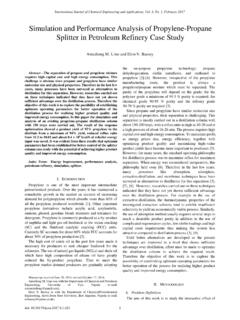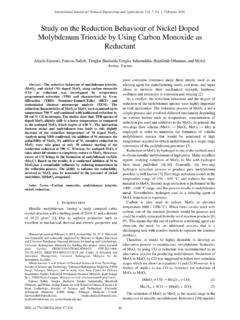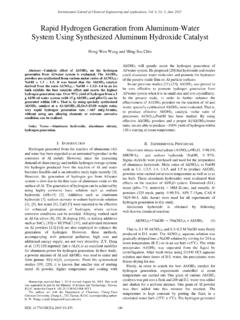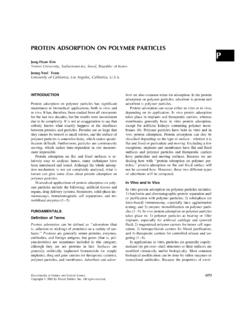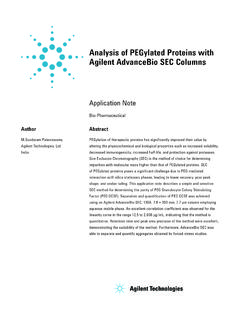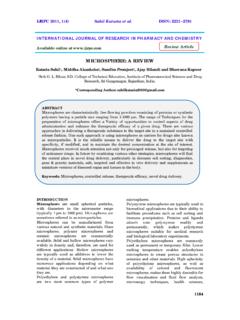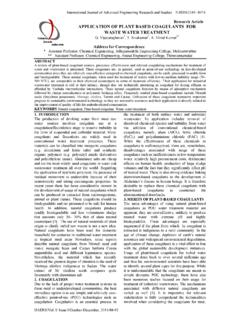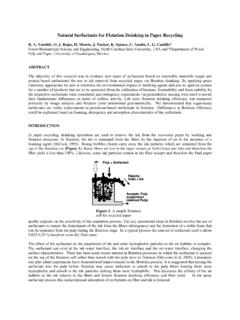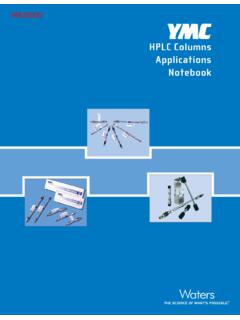Transcription of SiO Reinforcement of Mechanical Properties for Ebonite ...
1 International Journal of Chemical Engineering and Applications, Vol. 6, No. 3, June 2015. SiO2 Reinforcement of Mechanical Properties for Ebonite from Natural Rubber Nattawat Winya and Narupon Pittayaprasertkul industry are carbon black and silica, clay, carbon nano-fiber, Abstract To reinforce the Mechanical Properties of the and mica [7]-[11]. Silica is widely used as reinforcing fillers rubber compounds, the silica was added. In this work, we because it has a high specific surface area and performance to measured the tensile strength and hardness of the compounds, in improve the Mechanical Properties of composite rubber.
2 Which the amounts of sulphur and silica were varied from 45 to 60 phr and 5 to15 phr, respectively. The experimental results Silica is an amorphous material composed of silicon and showed that the addition of 10 phr silica 10 provides the oxygen atoms connected with silanol (Si-OH) both inside and maximum tensile strength and hardness. However for the on the surface. We would like to note that during the mixing amount of silica higher than 10 phr, the tensile strength tended process, the chemical reaction occurs between aggregates of to decrease.
3 We also observe that the amount of sulphur 60 phr silica and natural rubber chains. To avoid the complications, a with 10 phr silica gives the maximum hardness (73 shore D). silane coupling agent is needed to improve silica-rubber interaction and silica dispersion as well as to prevent Index Terms Natural rubber, silica, Ebonite , hard rubber, sulphur vulcanization. accelerator adsorption on the silica surface [12]-[16]. Liangliang Qu et al. studied synergistic Reinforcement of nanoclay and carbon black in natural rubber.
4 The result I. INTRODUCTION revealed that the marked enhancement in tensile strength from Hard rubber or Ebonite was rubber vulcanization processed Mpa for NR to MPa for NR composite with 5 wt%. with high amount of sulphur (30-50%). The Ebonite has a nanoclay and 20 wt% carbon black [17]. Sung-Seen Choi glass transition temperature (Tg) higher than the room found that influence of the modification of silica on reaction temperature. It has structured network and high hardness but behaviors of natural rubber vulcanizates reinforced with silica it is brittle, flammable, non-toxic, high resistant to chemicals, and carbon black were vulcanizates containing silane good electrical insulating Properties , excellent strength coupling agent recovered faster than those without the silane Properties , and able to manufacture.
5 The hard rubber is used coupling agent. Rattanasom et al. investigated the Mechanical as storage tanks, reaction vessels, and pump linings [1]. Properties of natural rubber reinforced with silica/carbon However, hard rubber is produced from natural rubber (NR), black hybrid filler at vaarious ratios in order to determine the styrene-butadiene rubber (SBR), and nitrile-butadiene rubber optimum silica/carbon black ratio found than the vulcanizates (NBR). containing 20 and 30 phr of silica in hybrid filler exhibit the The natural rubber or Para rubber is very important to the better overall Mechanical Properties .
6 Hsuen-Huan and economy of Thailand. The Natural rubber latex has typical Chi-Fang Chu studied Influence of clay, silicate and carbon composition are skim latex (total solid. content, TSC) is black on the environmental resistance Properties of hard approximately 36 %, water about 60 % by weight rubber (dry rubber. The result the carbon black has the best hardness and rubber content, DRC about 33 %), protein about , resin resistivity stability after the immersion test [18]. compounds about %, Ash is approximately 1 % and The objective of this paper is to investigate the influence Others, such as amino acids, lipids, phospholipids about the mixing amounts between mixing sulphur and silica on the %.
7 The outstanding Mechanical Properties of natural Properties of the rubber compound. The composite rubber rubber, such as elasticity and tear resistance. There are more investigated contains 45, 50, 60 phr of sulphur and 5, 10 and than synthetic rubber from petrochemical industry but natural 15 phr of silica. The Properties tensile strength and hardness rubber is easily degraded when exposed to sunlight, heat or are measured. non-polar organic solvents. Therefore, natural rubber usages required a modification process to improve its Properties and reduce its defects [2]-[6].
8 However, the use of a natural rubber II. MATERIALS AND METHODS. products is limited due to low physical stability. Therefore in A. Materials order to improve the Mechanical Properties such as tensile NR (natural rubber, STR 5L), Silica (VN-3), Fiber strength, tear strength, abrasion resistance, stiffness, and (Aramid-pulp), Antioxidant (Winstay S), Flame retardant hardness of rubber products, fillers were added into natural (Dechlorane Puls 515), Antimony Oxide, stearic acid, Silane, rubber. The most commonly-used fillers in the rubber Sulphur and oil.
9 Manuscript received May 30, 2014; revised August 29, 2014. B. Measurements W. Nattawat and P. Narupon are with the Operation Propulsion System, The Mechanical Properties were measured by tensile TECH. Research and Development Department, Defence Technology Institute (Public Organization) Ministry of Defence, Thailand (e-mail: 91202 serial according to JIS K6251. DOI: 169. International Journal of Chemical Engineering and Applications, Vol. 6, No. 3, June 2015. The hardness (Shore D) was measured by Teclock and optimum curing time (tc90) were observed for the GS-706N according to JIS K6268.)
10 Reinforced blends. The 50S-10 SiO2 system demonstrated an The density measured by METTLER TOLEDO (XS204) optimal curing time. The initial decrease in torque. according to JIS K6268. Fig. 1. displays the maximum torque (MH) of hard rubber The curing times (t90) of the compounds were obtained by compounds filled with various silica. It was interesting to find EKTRON at 170 C. out the maximum torque not much different when silica The compounds were subsequently compression molded increased in hard rubber compound with sulphur 40, 50 and by GOTECH (GT-7016) at 170 C, beased on the respective 60 phr, respectively.
